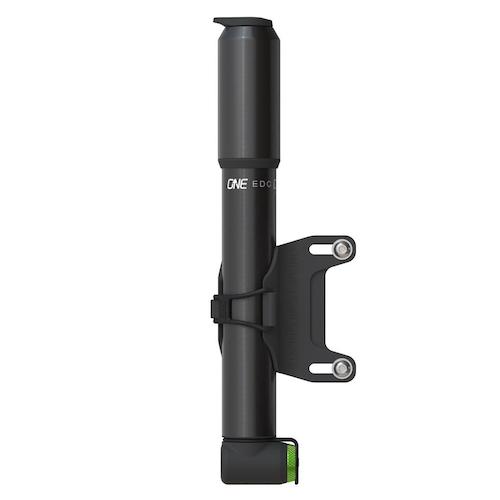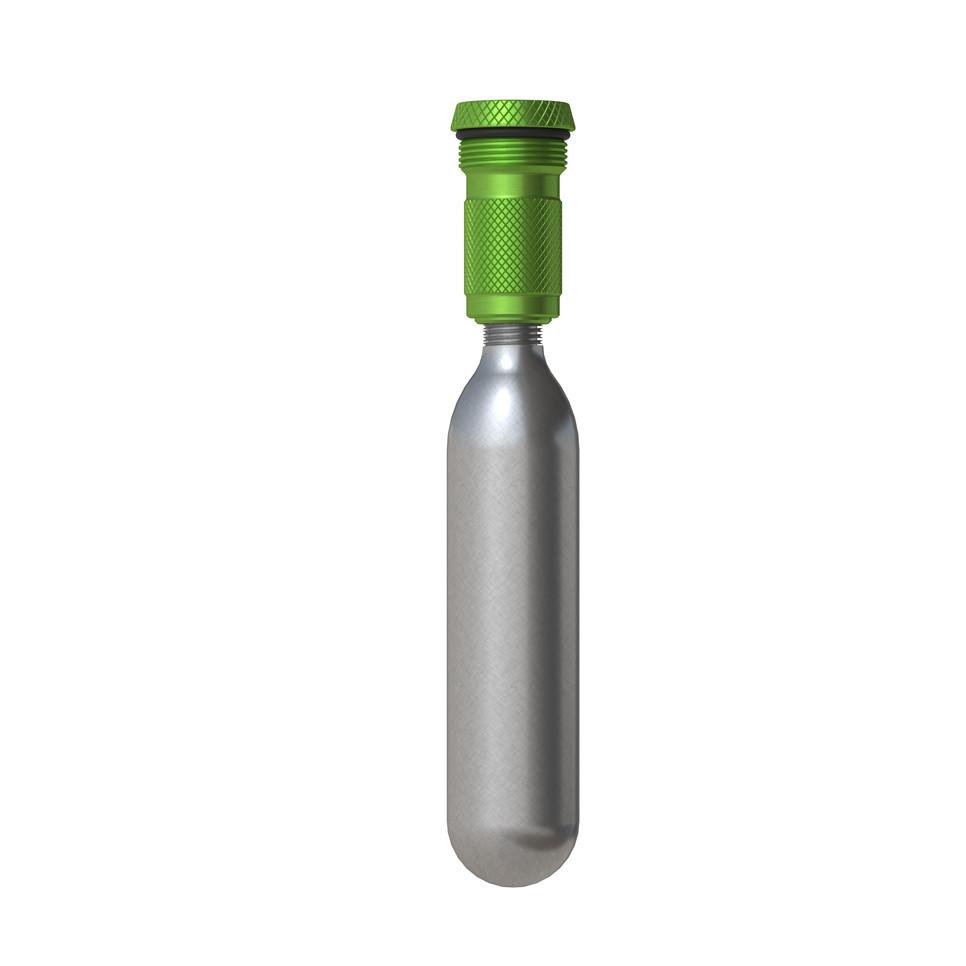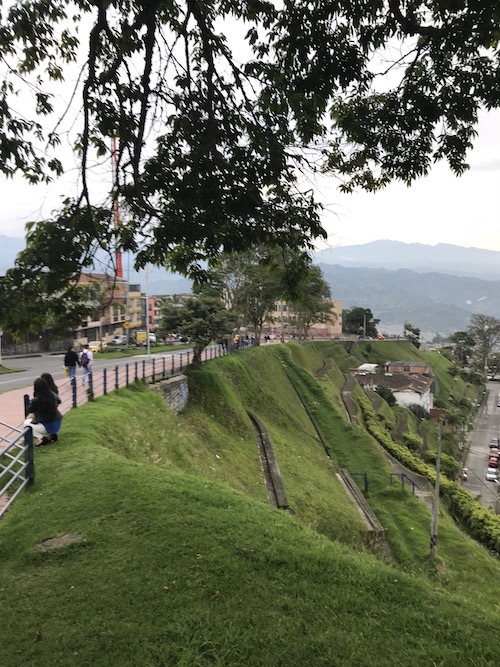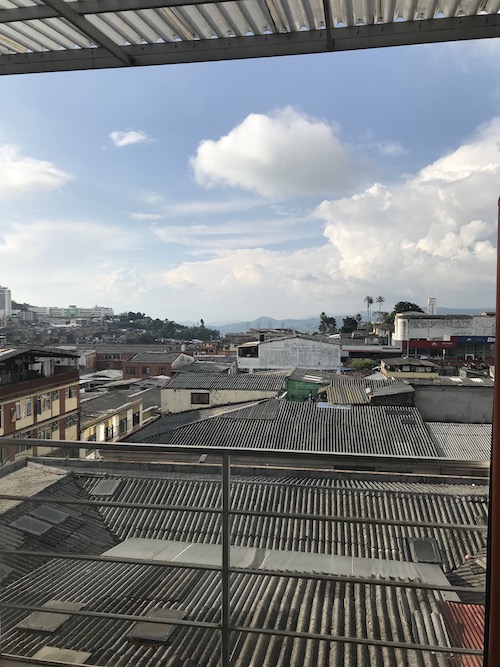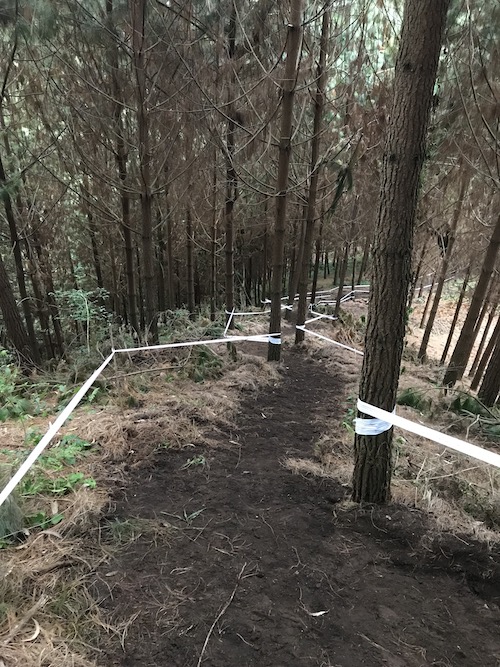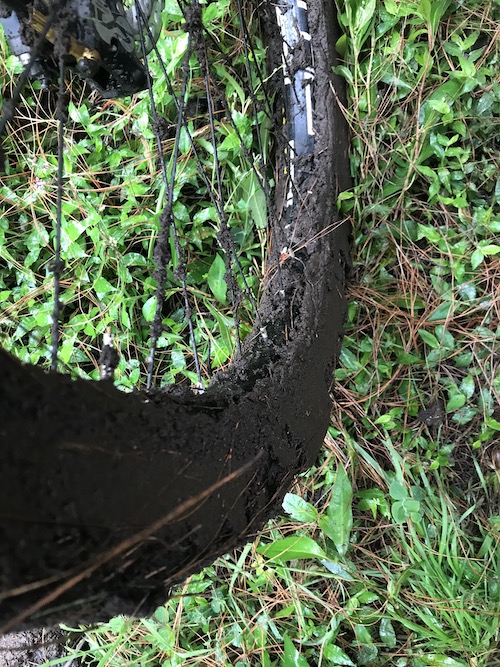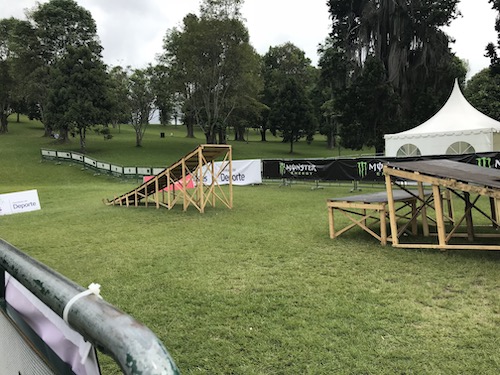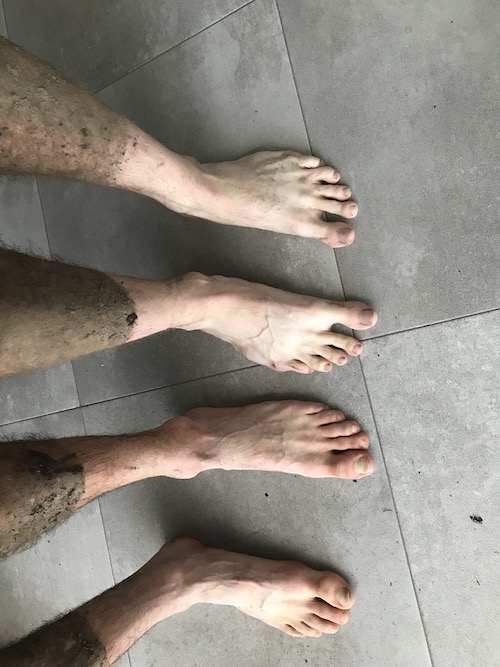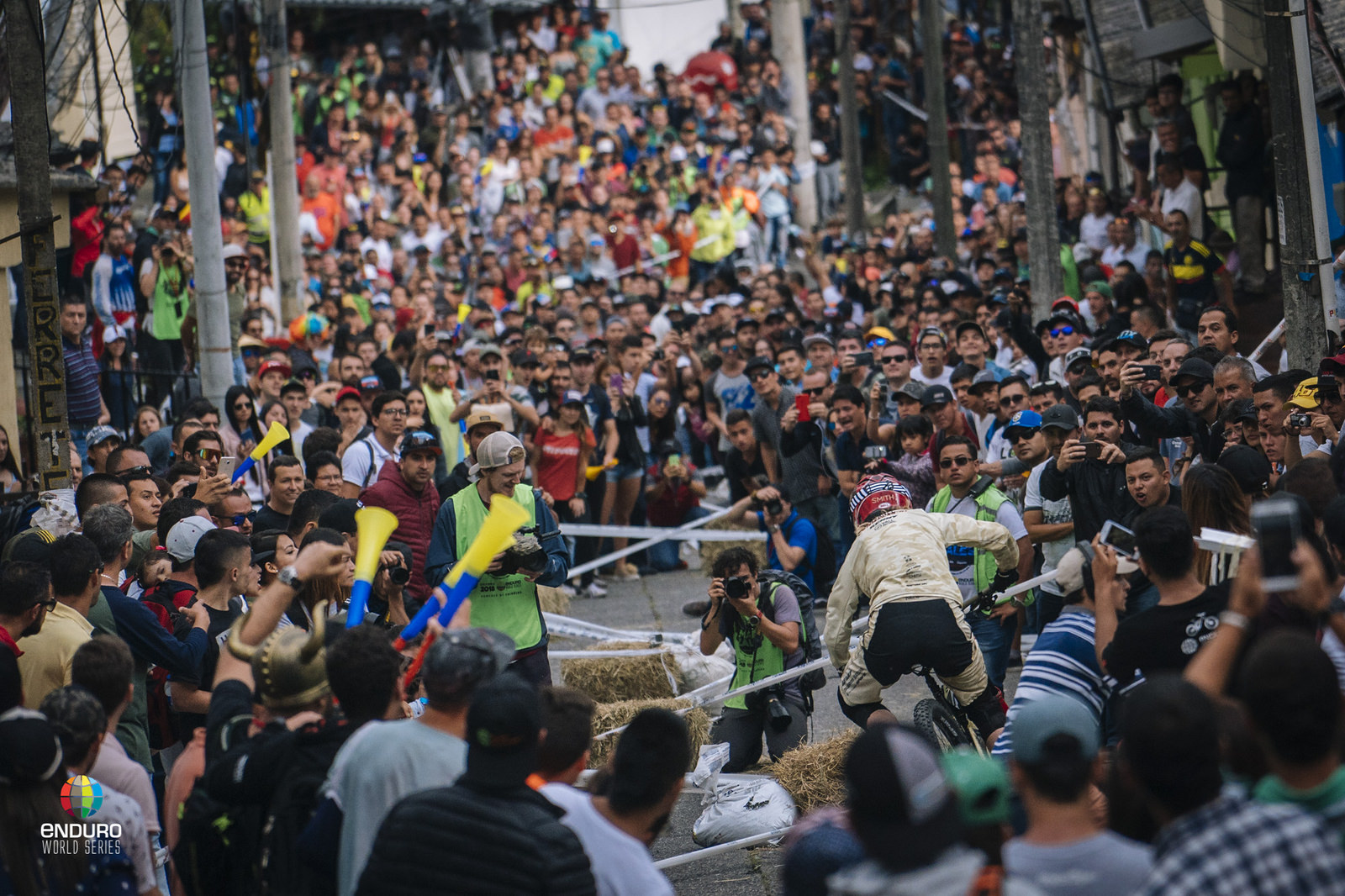Day 1 Practice:
Day one of practice started at 9:00 with all five of us piling in the rental truck and heading over to the bottom of the lift where stage 1 finished. The recommended route was that we go up to La Parva and take the lift from there and pedal over to stage 1 from the top, then take the chairlift and pedal back to the top of stage 2 where the team managers/mechanic/drivers would pick up the riders to take them back up to the top of stage 3, which started at the parking lot just above our accommodations in El Colorado. Since we didn’t have a driver or anyone to pick us up at the bottom of stage 2, we drove to the lift at bottom of stage 1. After completing it, instead of taking the lift back up, we drove back to the house to grab our rental car and dropped it at the bottom of stage 2 as a retrieval vehicle. There was a lot of waiting involved for those who weren’t driving and retrieving vehicles, but it was better than pedalling up the long hot roads. Save that for race day, right?

Click on the image to take you to a better quality version to be able to zoom.
Stage 1 wasn’t the highest point of the race, but it was pretty close. the views were quite amazing. Riding on the North Shore is deceptive because you never really see how high you actually are because of all the trees. In Chile there aren’t any trees on the mountains so you really get a good idea of how high you are and how far you’ve climbed.

Top of stage 1

The final push to the start line.
Stage 1 started off pretty steep and really loose and with no warm up, it was a bit of a shock. It went along the mountainside for a while with a couple of jumps, then went straight down and traversed across to another ridge. After this point, it kind of felt like the race organizers just taped off a 12′ wide section of trail and called it a race track. Very loose and rocky and since we were one of the first ones to ride it, the ruts hadn’t formed yet. Stage 1 would be the shortest of the race, but there was a long pedal section near the beginning, so it was in no way easy on the lungs. This being my first EWS and only being allowed one run per stage compared to 6 runs per day in a DH race, I thought that taking it slower and easy would be smart so I could see everything and get a sense of where I could go faster on race day and where I needed to be on the brakes. Even going slow, I had a crash in a super loose corner. Luckily it was sand like dust, and it was super soft to fall in, but I was surprised that I could have crashed going that slow on such an easy corner.
Stage 2 was hyped up to be the longest stage in EWS history, being 11km long and dropping over 1800 vertical meters. The part that wasn’t often spoken about was that it also had a 70 vertical meters of accent. That may not sound like much if you haven’t raced enduro, but imagine looking at a 70m tall building and having to ride up to that point during a race stage. The stage started off with a short-hike-a-bike from the top of the La Parva chairlift and finished all the way down on the 16th switchback of the road coming from Santiago. The first few minutes were probably my favorite part to ride of the whole race. It was super rocky and technical with lots of lines in some sections. Unfortunately, one of the guys in our crew put a big crack in his wheel and was unable to finish the stage. We were still high enough where he could ride down the road back to our house and put on his spare wheel. He wasn’t the only one having wheel/tire issues; there were lots of people spread out along the top section fixing flats. After crossing the dirt road at the bottom of the La Parva lift, the trail became less rocky and more dusty and ran along many different ridge lines with lots of awkward tight corners. There wasn’t really much worth mentioning here, so I’ll get to the good stuff at the bottom.

The last minute or so of the race was the most exciting. After 20 minutes of the top steep rocky sections and rough ridge traverses, your hands were already not feeling so great, but that didn’t matter. The hardest part was still to come. The trail started getting steeper and faster, and as soon as you hit some vegetation, things got really steep. This is the only section we walked before practice and I was glad we did. There were quite a few lines we found that prevented a potential crash from riding it blind and going the wrong way.

follow the finger in between the rocks
On race day, we would be riding up over 8.5 km on the same road we took to drive up to Farellones. Very long and very hot. After a long wait for the truck to be retrieved, we headed up to the top of stage 3. Stage 3 started with some open flat turns that went into some massive berms filled with huge rocks and ruts. Anthony had a crash there and took some skin off his hand, which didn’t seem too bad, but turned out to be not the greatest thing to happen on our trip. After the berms, the trail linked to a bike park trail that was similar to the top of stage 2 with lots of loose rocks, drops, and some gap jumps. There were two pretty big climbs near the finish line at the bottom which was a good way to finish up the day. There was a choice; you could either ride up on the dirt road back up to the race village or take the extremely slow chairlift which took the same amount of time to ride your bike up the hill. I took the chairlift.
Day 2 Practice:
Day two of practice started at the top of the La Parva lift and was one of the more physical stages, and also the most technically difficult for me. I really struggled with all the tight flat corners near the bottom that seemed to have no good “line”. It also had some wide open pasture sections where there was no tape for hundreds of meters. That was wild! One minute you’re racing an EWS and the next you’re riding your bike through a huge flat horse pasture.
The transfer between stage 4 and 5 was my least favorite. It was a mix of hike-a-biking through mountain valleys, getting all sorts of prickly things in your shoes, and trudging through muddy cow patty filled fields. Not the most fun, or sanitary, but I guess that’s just the way it goes!
Stage 5, the shortest of the race, started from the bottom of the main race village. The top part was steeper with some really tight switch back corners filled with dust and rock, then it went through a stream. Even when you’re in a place where it hasn’t rained for 5 months, your bike still gets muddy. The bottom part was very loose, hard-packed dirt with slippery corners, which ended just up the road from where stage 2 finished. Only 6km of switch backs to climb this time! Again, we were able to put our two vehicles to good use and drove up for practice.
Stage 6, the second longest and second most physical, started from the highest point on the mountain, above stage 2. From the start line, you could see the race village and the finish line. You don’t get that in mountain bike racing very often.

Middle right of the image you can see the race village, with the finish line. Yeah, we had to go all the way over there.
Similar to stage 2, the top of stage 6 was a bit more rocky and technical, but also had some super fast wide open sections. Unfortunately, one of the guys in our crew got a front and rear flat from the same rock. As I helped him fix it, two other people did the exact same thing. I didn’t end up finding the rock, I just hoped I wouldn’t hit it on race day. The stage was overall pretty fast, except for one part where it sent us along a ridge that was super loose and dusty with huge rocks, making it hard to hold on. After the ridge, it went down into the valley, but of course, this is enduro, so It has to go up. The stage continued on the other side of the small valley after the climb and got really fast and rough. I really enjoyed this part, and pinned it even though I had no idea where the trail went. Stage 6 joined up with the top of stage 3 in the open flat corners and finished just after the huge rutted out berms where Anthony crashed.

Even though it was sunny, it was cold up there!
Other than the wheel and tire issues with two of the other Canadians, up to this point we had no major mechanical issues the whole week. I couldn’t thank Jean Christoph and Peter Gustafson from Fox enough for what they did for us in Chile and Columbia. They went above and beyond for us, even outside of our suspension needs. I was very humbled and feel like we got Factory treatment even though we were just privateers!

Fox Techs adding some volume spacer to keep the front end a little higher
We got lucky with an awesome sunset the night before race day as we cooked up some steak for the next couple days.

Race Report Day 1:
Luckily Anthony and I started right after one another, me being in front, so we both had to be at the race village at 9:15 to get our timing chips and stickers and start the day. In EWS racing, they give you 5 stickers for your bike which you can’t remove, otherwise you’ll get a 5 minute time penalty. One on the front triangle of your bike, one on the rear triangle, one on each wheel, and one on your fork. That means if you break something that the sticker is on, you either have to deal with it by riding on the broken part or take the time penalty.
We got a shuttle up to the base of La Parva and pedalled to the chairlift. It was a nice warmup to start the day. We got to the top of stage 1 to see a huge amount people at the top; a lot more than we were expecting. Apparently, the race was half an hour behind and they had sent the email to notify us at 9:30. Really helpful, especially since we didn’t have cellular! We were waiting at the top for about an hour before we dropped in, but luckily we had some sun and good company so it wasn’t so bad.
Stage one went alright for me, I didn’t push as hard as I could have on the long pedal, but I passed the guy in front of me right before it got narrow so I didn’t lose too much time from that. The time gaps were only 20 seconds between riders so we were all really close and most of the time, able to see each other. I survived my first EWS stage with no crashes or mechanicals! Only 5 more to go. Anthony had a minor mishap, breaking a shifter cable, which didn’t cost too much time and he was able to change it in the gondola on the way to stage 2.
After a couple chair lift rides and a bit of pedalling (with one lift having to hold your bike out in front of you) we made it to stage 2. I was a bit nervous at the top thinking about riding 11km non stop down hill. For reference, most of the trails on the north shore are 1km, maybe 2 if you link up a couple from top to bottom. My time came and I scared myself really good a few times in the first 20 seconds, almost sliding out on a couple of corners. I decided to go for it and ride like I normally would at home. I learned pretty quickly I couldn’t do that in the Chilean dust, and had to tone it down a bit, but the technical top section went pretty well after that. There were a couple moments where I second guessed my choice of tire pressure and felt like I should have gotten a flat tire, but luckily I wasn’t one of the ones on the side of the trail putting in a tube! I was able to pass the guy in front of me, but it took a while longer than before. He didn’t seem to want to move over. The flatter section in the middle went ok. I was still passing people every once in a while and took the smoother sections easy to rest my hands and feet to try to save them for the bottom. Looking back now, I still don’t know if it would have been better to pedal in these sections, or just take them easy like I did. I got close to the final steep section and could hear the crowd that was there. They went nuts as I was riding through and it was hard to focus on the lines, but walking them before practice definitely helped keep me on track and I was able to make it to the bottom without any major issues. I feel satisfied with how I did on such a long stage. Looking back, it was probably one of my favorites and one I felt I rode the best. Only one major mistake and no crashes. I think I could have pushed a bit harder on the flatter sections where I chose to rest my hands, but other than that, I think I rode pretty well.
The part I was dreading most about the whole weekend, the 8.5 km climb to the race village, was next. There was a feed station about 1/4 way up the climb where I planned on refilling my water and getting some snacks and stuff, but I was also conscious of making the start times. In EWS racing you get a sticker on your bike with all your start times. You have to make it to the top and start at the time on the sticker, otherwise you’ll get a time penalty. I was worried I wouldn’t make it since I wasn’t used to having a time where I had to be at the top, so I ended up not waiting for any of the guys I was riding with and riding right past the feed station without knowing. Yes it was mostly my fault, but it could have been marked better. It was tucked right behind a little cafe on the side of the road as I learned as I got 3/4 of the way up and asked somebody else how far away it was. Whoops. Luckily I wasn’t super low on water and had enough to make it to the top without getting dehydrated. It was a shame too, because I was over 45 minute early for my check in time before we headed up to stage 3. Lesson learned I guess.
I filled up on water and snacks and got through the time check and hopped in the shuttle to the top of stage 3. I only had about 5 minutes at the top before my time, but I was watered, fed and rested, so it didn’t bother me not being at the top for a little longer.
The top of stage 3 went ok, not quite knowing how much to push on the flat open corners based on how easily it was to crash, but I carried good speed through most of them and made it to the bike park section. On the two steep climbs is where I felt I lost a lot of time. Anthony didn’t catch me, but I felt like he was getting close after I crossed the finish line and he crossed less than 20 seconds later. We both slowly moved towards the chairlift to go back to the village to time out for the day.
Day 1 of racing was over, and neither Anthony or I had any crashes or major mechanicals. Unfortunately for one of the other riders staying with us, he cracked his rim on stage 2. He was optimistic for the next day hoping that a tube would hold air so he wouldn’t have to take a 5 minute time penalty for removing one of the stickers and replacing his wheel. Unfortunately, his wheel didn’t hold together and he would have to pull out of the race after stage 4 the next day.
Race Report Day 2:
After checking over the bikes, good food and a good nights sleep, I woke up the next morning not feeling as good or fresh as day one. I guess pushing the lungs hard at high altitude will do that. We were suppose to receive our start times for day 2 at 9:00 the previous night, but even checking right before bed at 9:30, they still hadn’t come. That was a little scary going to bed not knowing if you had to start an hour earlier than the first day, but fortunately the start times were almost exactly the same as day 1.
The short climb through La Parva seemed a bit harder than the previous day, but was still a nice warmup before stage 4. I wasn’t really thinking much about stage 4 and the issues I had on it during practice, but maybe that was a good thing.
Right out of the gate, I could feel my lungs hurting and knew it was going to be a rough day. The top technical part went alright but once I got lower down and caught up to the guy in front of me, I really struggled to pass. It was quite tight and he didn’t want to pull over to risk ruining his time, which annoyed me. Unfortunately, it didn’t annoy me enough and I ended up following him for quite a while and Anthony came up right behind me and made a very aggressive pass on both of us. I was a bit stunned and thought I should do the same, but before I could, another Canadian from behind me did the same thing and passed both of us. We were now all in the flat open pasture with no tape, and I had finally had enough of the guy in front of me not moving over so I shifted into my lowest gear and sprinted past both of them and all the way up until it went back into the taped section where it got a bit more technical. Then, I crashed in the first corner, getting passed by both of the people I had just passed. To make things worse, I had also twisted my handelbars and tried to ride them like that until I crashed a couple more times and got passed by some more people. I accepted my defeat and pulled over to straighten my bars. I made a couple more passes as I made my way down, but was very disappointed and angry of what happened. I noticed Anthony sitting by a bush near the finish line with people asking if he was ok and he seemed to shrug it off. I was annoyed and in some pain myself but knew that the transfer was difficult and we didn’t have very much time to make it, so I knew I had to hurry up if I wanted to make my start time, especially considering how much I had lost in that stage.
I made it again, with only 5 minutes to spare to get my helmet and gloves back on to start stage 5. I noticed Anthony wasn’t behind me when I started, and I was wondering if he had been a bit too casual with the transfer and missed his start time by mistake. I didn’t find out until the end of the race that he had pulled out of the race because of crash that he had lower down on stage 4.
Stage 5 started off well and I tried to put stage 4 behind me. I caught up with the guy in front of me rather quickly, but this time there was absolutely now way I could pass with the trail being so narrow. He almost crashed a couple of times so I got excited and thought I was my time to make a move, but it didn’t happen and I had to eat his dust all the way to the bottom. In the middle of the course or even lower down there were places that I could have passed, but I wasn’t nearly aggressive enough. That annoyed me that I made that mistake again and that It was costing me so much time. You would have thought that I would have learned by now, huh?
This time, I made sure I didn’t miss the feed station before the 6km switch back climb, and I took it a bit easier knowing how long it took me the first day. I was surprised I didn’t see Anthony at the time check but continued on up to the highest point of the mountain to finish the day. A truck ride, a seemingly very long and hard climb through La Parva, a chairlift, and hike-a-bike later, I arrived at the top of stage 6, the final stage of the race. I had 50 minutes until it was my time to go, so I tried to have a little nap, even setting my alarm in case I actually did fall asleep. I didn’t, but the rest felt good and I was ready to get on it for the longest and hardest stage of the day.
I caught up with the guy in front of me pretty quickly again and struggled to pass. Luckily for me, he crashed soon after I caught up and I was able to make the pass without seeming like a jerk and continued at my pace. Similarly to stage 2, I felt satisfied with how I rode 6: smooth and consistent, not going too hard and burning out on the long uphills, going fast where I could, and taking the smooth sections to rest my hands and feet. Stage 2 and 6 should have been the ones I struggled with most because of the length and all the pedalling, but I felt like I rode them the best (funny how that works). The crowds were going wild at the huge berms near the bottom of the stage and I crossed the finish line jump relieved that I had finished, but also a bit worried about Anthony. Shortly after I finished he showed up and explained that he had to pull out of the race.
After hanging out at the race village and waiting for the rest of the riders to come down, we headed back up the house to pack up to leave for the airport the next morning. Anthony was obviously disappointed with the race because it was the only one he hadn’t finished. I was glad I finished, but was disappointed with some of the mistakes I made and the whole of stage 4 where I lost a lot of time. Looking back at it now, I realized I just need to be less “Canadian” and be more competitive and pass people as soon as I can. For my first EWS I was pretty happy with the experience overall, of racing on a new continent and was excited to get on the plane to see what Columbia had in store.

Our last night in Chile left us with a stunning sunset which I won’t be forgetting anytime soon.
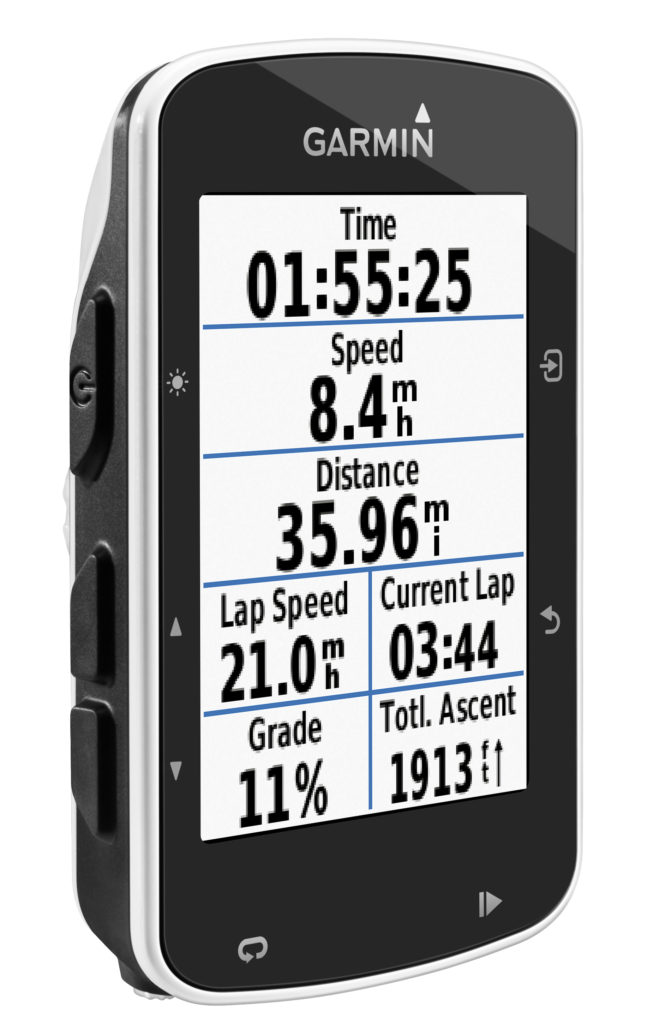



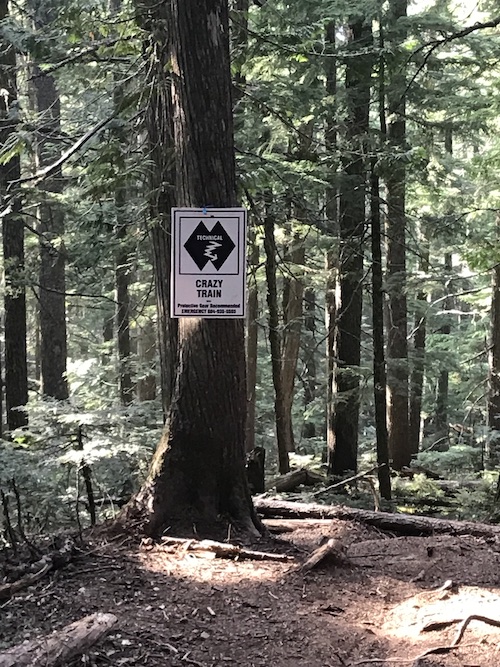
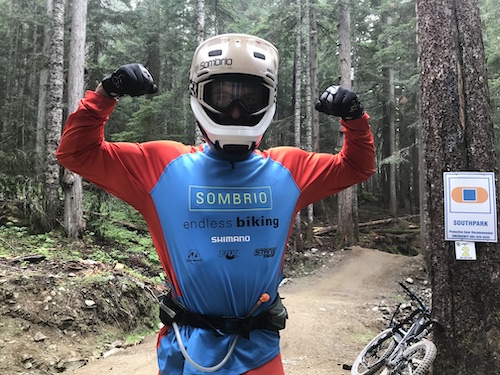
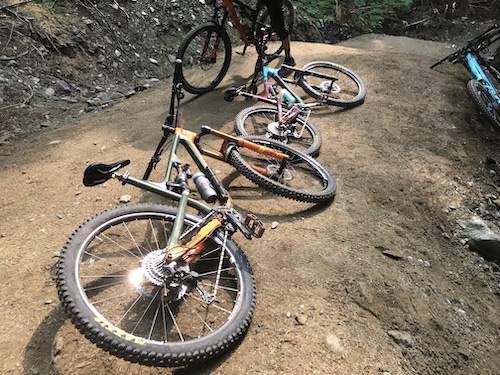



 After almost a year of use, It’s time for a long term update for the One Up EDC Tool. After I got back from my trip to South America where I broke the mount for my hand pump that attached the pump to my bike, I started looking around for a new hand pump to attach to my bike. The pump itself was also starting to wear out, it being our only pump that Anthony and I took on our trip, it got used a lot to up the tire pressure before rides, fix flats, and even seat multiple tubeless tires.
After almost a year of use, It’s time for a long term update for the One Up EDC Tool. After I got back from my trip to South America where I broke the mount for my hand pump that attached the pump to my bike, I started looking around for a new hand pump to attach to my bike. The pump itself was also starting to wear out, it being our only pump that Anthony and I took on our trip, it got used a lot to up the tire pressure before rides, fix flats, and even seat multiple tubeless tires.